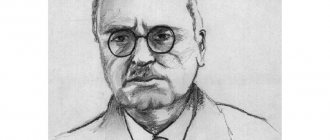Delusions of grandeur or megalomania (also called delusions of grandeur, but this is incorrect) are determined by a set of internal symptoms, as a result of which the patient exceeds significance and overestimates his own qualities and abilities. An idea of a famous, wealthy person with opportunities that ordinary people do not have is formed.
The megalomaniac considers himself a king who knows everything. There are often cases of special purpose. When determining the disease, a conversation is held and behavior is observed. There is no specific treatment approach. Mood stabilizers, antipsychotic drugs and tranquilizers are used to slow the progression of the disease.
What is megalomania, megalomaniacal delirium, expansive delirium
“Delusion of grandeur”, a term common among professional psychiatrists. The appropriate name is “delusions of grandeur.” Megalomania, megalomaniacal delusion and expansive delusion refer to the same disease, but are used less frequently.
Photo by Ian Noble on Unsplash
The risk of developing the disease is higher in men. As a rule, the main signs are considered to be aggressiveness and persistence in defending ideas without evidence. The disorder develops against the background of paranoia, schizophrenia and manic-type syndrome.
How to deal with a megalomaniac
To avoid aggression towards yourself, it is necessary to demonstrate respect and interest in the ideas and “achievements” of the patient. Give enough time and attention to a conversation with a megalomaniac.
If a mentally healthy person has a close emotional connection with a patient, there is a risk of developing induced delusions or “delusions together.” As a result, a healthy person adopts the delusional ideas of a megalomaniac. You should be especially careful if a person or child in love with him communicates with the patient.
Symptoms of delusions of grandeur
The main symptom of delusions of grandeur is the concentration of the individual on his superiority over the people around him. If a person has a disease, he thinks that he is more powerful than others, richer and more educated. He seems to be haunted by fame and fortune. The patient thinks about the power and trust of others. There is a constant categorical defense of one's own position.
Photo by Henry Hustava on Unsplash
People with delusions of grandeur are demanding, and want to be treated according to their imagined status as a great person. Frequent mood changes are one of the symptoms of a delusional state. Against this background, an emotional imbalance is formed. Aggression is replaced by a kind attitude and euphoria. Such people suffer from frequent depression.
When the disease is in the development stage, or the intensity decreases, there is a negative attitude towards criticism and advice from others. High self-esteem is taken into account. The opinions of others do not exist, only your own importance is important. There is absent-mindedness and increased activity. A person suffers from anxiety attacks.
In this state, sleep disturbance becomes the norm. Male aggression increases. The disease in the stage of high activity is characterized by an increase in delusional fantasies.
It seems to patients that they are the rulers of the universe and the saviors of humanity. Euphoria often sets in here. Delusions of grandeur are characterized by a complex disorder. The cheerful mood gives way to sadness and aggression. There is an increase in motor activity and emotional excitability. Depending on the content of delusional ideas, symptoms vary:
Aristocrat
If the patient imagines himself to be a born aristocrat, belonging to a noble family, then a delusion of a special origin is determined. An unhealthy imagination creates the image of a child born into a family of famous people, for example, writers or rich people. The delirious person talks about his wealth, shares the presence of many valuables.
Photo by Thai An on Unsplash
Despite the condition, the narration sometimes occurs in a fairly truthful manner. But more often than not, it looks ridiculous and emotional. The degree of delirium starts from several hundred thousand dollars and can reach castles filled with jewelry.
Delirium of a scientist inventor
The disorder is characterized by the patient's belief that he is a great designer and innovator in the field of technology. These include the creators of medicines that will save humanity from all diseases. The patient places the emphasis not on the invention, but on her personality.
Delirium of love
Representatives of the weaker sex are more susceptible to the disorder. A woman believes that a high-ranking man, for example, a famous statesman or businessman, is in love with her. A high level of daydreaming leads to the creation of this kind of illusion.
The delirium of the great reformer
The patient considers himself a great revolutionary, capable of changing the economic situation or becoming a reformer of the social system. As a rule, such ideas are characterized by emotionality, but not concrete actions.
Antagonistic delirium is defined as the opposition between good and evil, light and dark, life and death. Delusions of altruism generate ideas in which the patient imagines himself as the savior of the world and humanity.
Symptoms and signs
Persecution mania - what kind of disease?
The characteristic signs of “great madness” include the following types of behavior and reactions:
- Self-focus, self-obsession. Other people's problems and experiences are not of interest and are not noticed.
- Complete rejection of someone else's point of view. One’s opinion is perceived as the only one worth attention and correct. This can lead to behavior that is dangerous both for the megalomaniac and for others.
- Tendency to exalt one's ideas and thoughts. Confidence in one’s high importance for society and the world as a whole. For example, a person may believe that he knows how to solve all the world's problems. At the same time, he will expect and demand from those around him confirmation of the genius of his conclusions.
Delusions of grandeur manifest themselves not only on the mental and emotional level, but also on the physical. A megalomaniac may experience increased motor activity and nervous excitability, and problems with sleep (insomnia).
In the case of bipolar disorder, high activity during the manic phase may be followed by periods of passivity, a feeling of constant fatigue and “sluggishness.”
Depression and suicidal thoughts are other characteristic symptoms of megalomania. Such conditions develop in the patient as a result of severe mental and physical exhaustion, which comes after a period of euphoria from thoughts of one’s omnipotence and super-worth.
Why does delusion of grandeur develop?
Delusions of grandeur are characterized by a violation of the quality of thinking. The process of logical perception of information is distorted. A worldview is formed that seems real to the patient. In fact, there are ideas that are different from the present, becoming a product of delusional imagination. The basis of delirium is physiology. Personality characteristics and experience determine the content of delusional ideas. Thinking is disrupted, perception of the environment deteriorates. Memories become abrupt.
Photo by Davide Cantelli on Unsplash
Such nonsense develops in stages. The basis is a delusional mood. This is the first stage. Arrogance begins to dominate. A person considers himself better than those around him. Subsequently, the perception of one’s own personality changes. The idea of superiority is formed. The culmination is the patient's behavior. The patient behaves like a head of state or a deity.
Factors in the development of the disease include social, psychological, physiological and genetic prerequisites. The features of delusions of grandeur are specific. People with unstable self-esteem and a desire for leadership and superiority are more susceptible to developing the disease.
Delusion or crazy idea
A delusional idea is a false judgment characterized by the simultaneous presence of the following characteristics:
- “pathological soil”, i.e. delirium necessarily arises on the basis of illness;
- extreme significance for a person;
- complete mastery of the patient’s consciousness;
- indisputability (the idea clearly contradicts reality, but it is impossible to dissuade the patient) [I. Martynikhin, 2015].
To better understand the essence of delusional ideas, let's consider their main classifications.
Types of delirium by scale and unusualness
The first classification involves dividing delusions according to the degree of scale and unusualness. Thus, there is delirium of everyday relationships, which is also called minor delirium , and a more severe form of delirium - megalomanic delirium:
- Delirium of everyday relationships manifests itself in the everyday sphere and covers one or more representatives of the patient’s immediate environment (relatives, friends, neighbors, etc.) Usually manifests itself in the form of ideas about damage: for example, the patient is convinced that his neighbors are screwing him up every day threatening letters in his mailbox, or his mother purposefully feeds him expired food.
- Megalomaniacal delirium has absolutely absurd and fantastic forms on a grandiose scale. It is manifested by ideas of greatness (“I am the Lord of the Galaxy, I have control over matter, space and time”), self-blame (“Because of me, Jesus Christ was crucified”) and hypochondriacal ideas (“I was infected with a terrible disease, now all humanity will die out” ).
Thus, delusions can take the form of both absolutely absurd ideas and quite plausible ones, which greatly complicates its diagnosis.
Types of delirium according to degree of systematization
The second classification involves the division of nonsense according to the degree of systematization of ideas. So, they distinguish:
- Systematized nonsense is a structured and interconnected system of individual ideas, which is supported by specific evidence and facts.
- Unsystematized nonsense - fragmentary ideas that are in no way connected with each other.
Systematized delusions, as a rule, are the result of a long and gradual development of delusional ideas, and unsystematized ones in most cases indicate the acute formation of a deviation.
Types of delirium according to the mechanism of formation
Delusions have several causes and appear as a result of impaired logical thinking or incorrect assessment of reality, and can also be transmitted from other people.
Depending on the mechanisms of formation, delirium is divided into three types:
- Delusion of interpretation is a systematic delusion based on erroneous interpretation due to impaired thinking. A person interprets real facts and events selectively: he chooses what corresponds to his idea, and rejects the rest of the information, resulting in an erroneous perception of reality.
- Sensory delirium arises due to the fact that a person relies not on logic, but on intuition when making a judgment, i.e. feelings are perceived by consciousness as an objective reality that does not require any grounds or evidence.
- Induced delusions are the result of “infection” with delusional ideas from another person. It occurs if it has a believable appearance, and the inductee has high suggestibility and communicates with the inducer for a long time. It is well illustrated by the example of group delusion among sect members.
Delusions of interpretation are the most persistent, sensory delusions can be partially corrected, and induced delusions are the most fragile and usually disintegrate when a person is separated from its source.
Types of nonsense by content
The most obvious is the classification of delusional ideas according to their content, but its analysis has limited diagnostic capabilities, since the plot of delusions largely depends on secondary factors, i.e. not from the disease itself, but from the environment in which the person is located. The formation of delusional ideas is greatly influenced by the era in which the patient lives, his social environment, interests, etc.
However, there are three main contents of delusion , which are found everywhere:
- Delusions of persecution (paranoid delusions) are a person's belief that someone is following him, wanting to harm him. This causes panic, anxiety, fear and despair, as a result of which the patient seeks to avoid persecution by isolating himself from his pursuers (by moving to another city, without leaving the room, installing several locks, etc.) or by trying to turn them “from a hunter into victim" (the person himself begins to persecute his ill-wishers, threaten them, and sometimes use physical aggression).
- Delusions of self-blame (depressive delusions) manifest themselves in a person’s persistent conviction that he is guilty of something terrible and will certainly be punished. It is the most dangerous type of delusion, since it often pushes patients to commit suicide, including extended suicide (the desire to kill not only themselves, but also all their relatives in order to protect them from paying for the sins of their relative).
- Delusions of grandeur (manic delusions) take the form of a significant overestimation of one’s own uniqueness and importance, as well as one’s capabilities [I. Martynikhin, 2015].
Now we have reached the main topic of our article. “Delusions of grandeur” – what is it from a scientific point of view? To answer this question, it is necessary to study why megalomania occurs, the signs and symptoms that characterize it.
Causes of delusions of grandeur
- Organic damage to the central nervous system. Characterized by the lack of clear systematization in the development of delirium;
- Split personality. Systematization and stability of symptoms is a distinctive feature. The disease occurs in a paranoid form.
- The idea of superiority is formed;
- Paralytic dementia. Characterized by late syphilis. Megalomania develops on average in 5% of patients;
- Manic-depressive psychosis or bipolar affective disorder. In the manic phase of psychosis, symptoms of delirium appear. Activity exceeds acceptable norms, and one’s own capabilities are overestimated. I lose control of myself.
Depression and consequences of megalomania
Delusions of grandeur, oddly enough, are often replaced by a conviction of one’s own worthlessness. This happens when the patient loses confidence in his importance and power over the world. Returning to reality is very difficult and usually leads to the development of severe depression.
Therefore, it is important not only to rid a person of delusional judgments, but also to provide him with psychological support when the manic phase gives way to a depressive phase, to convince him of the value of his personality, regardless of life’s achievements and the recognition of others.
How is delusions of grandeur defined?
The diagnosis of the disease is carried out by a psychiatrist. Megalomania is defined as a derivative of an underlying mental disorder. Clinical studies are underway. The first thing to be examined is the brain.
With an integrated approach, the following activities are carried out:
- Preliminary conversation. During the conversation, the doctor gets to know the patient. Symptoms characteristic of delusions of grandeur are identified. The conclusion is made based on the person’s life experience and the characteristics of the development of the disease. Patients with megalomania are open, willingly talk about life and freely share their thoughts. The basis is the main disease. Schizophrenic delusions are characterized by fantastic nature. Absurdity is noted in Bayle's syndrome (progressive paralysis);
- Behavioral Research. Human behavior is characterized by changes in mood. The patient may be sad and suddenly become cheerful. There is increased activity. In other cases, there is looseness and failure in choosing goals. Sometimes laughter occurs for no reason. They may behave ambiguously with staff, disrupting interpersonal interaction;
- Study of disorders of mental processes. Pathopsychological testing is carried out. The testing is based on conventional methods for studying the characteristics of thinking, attention and memory.
Diagnosis of megalomania
Delusions of grandeur are diagnosed only by psychiatrists, based on information obtained during a conversation with the patient and his relatives, determining his lifestyle, listening to complaints, and taking an anamnesis. Diagnosis of the disease can be divided into several stages.
Conducting a conversation with the patient. It is effective if a person admits that he has a mental disorder, which is extremely rare. During the conversation, the patient describes his complaints, disturbing thoughts, and presents his own vision of the situation.
Conversation with loved ones. The close environment of the patient makes it possible to detect features of his behavior that violate the norms established by society, and to establish the date of onset of the disorder.
Conducting an experimental psychological examination. The method consists of psychological testing of the patient, including:
- conducting studies of cognitive function;
- research of the emotional component;
- research into personality structure.
Research is carried out in the form of testing, and allows us to determine the dynamics of the development of the disorder, its trigger mechanisms, and determine the characteristics of the course of megalomania.
Carrying out instrumental diagnostics. It allows you to identify organic brain lesions and consists of the following:
- An electroencephalogram is performed to detect the electrical activity of the brain.
- Carrying out a CT or MRI of the brain to determine circulatory disorders or organic damage to the brain.
What does the late stage of megalomania lead to?
Complications of delusions of grandeur include depression coupled with thoughts of suicide. Patients with manic-depressive psychosis are in the main risk group. If the period of a manic state was quite bright, then the depressive state will be severe.
Photo Hasty Words from Pixabay
There comes disappointment in one’s own strengths and ideas that have not manifested themselves in reality. Depression provokes suicidal thoughts. The patient seeks care from others, convincing them of his own insignificance and uselessness.
Main causes of the disease
Fear of people and society - what is this phobia called and what is it
Psychiatrists consider megalomania as a component of paranoia, manic syndrome, schizophrenia, and paralytic dementia. People whose close relatives suffered from these diseases are at risk. Transferred or advanced syphilis can also trigger a pathological process in the brain.
Sometimes the syndrome can develop in an individual with high self-esteem. The trigger in this case is a previous nervous breakdown or neurosis.
Important! Alcohol and drug abuse can trigger the development of delusions of grandeur.
Forecast and treatment of delusions of grandeur
To eliminate megalomania, a comprehensive approach is taken to get rid of the underlying cause. The correct approach in the treatment of progressive paralysis, manic-depressive disorder, and schizophrenia helps to gradually get rid of delusional ideas.
Medicines are prescribed only by a doctor on an individual basis. Treatment uses tranquilizers, antipsychotics and lithium-based drugs. If the disease is severe, hospitalization is required. Mild forms are treated at home or in a facility. In conclusion, it is necessary to prepare a person for leading a social life.
Diagnostic methods and treatment methods
The disorder can only be diagnosed by a psychiatrist. A psychologist has the right only to suspect the client has a mental disorder and refer him for examination to a specialist in the field of psychiatry. A psychiatrist makes a diagnosis only after a personal conversation with a person whose relatives or psychologist have noticed signs of megalomania.
Next, the specialist prescribes medications aimed at treating the underlying disease and relieving the symptoms of delusional symptoms. Psychotherapeutic support is not cancelled.
Psychotherapy must necessarily complement drug treatment
In especially severe cases, when the patient’s behavior becomes dangerous for others or himself, hospitalization may be required.











